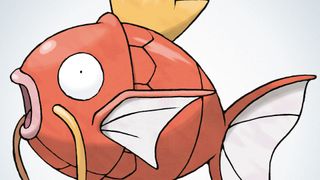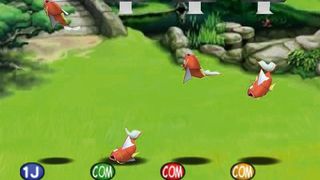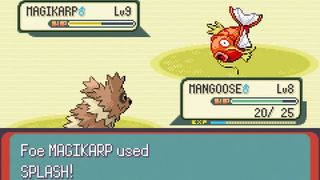Games often contain jokes, but it’s rare for them to play one on their own audience. Pokémon's Magikarp, however, is a practical joke, a raspberry blown in the direction of the player. It’s useless, stupid-looking and ubiquitous. Even more damning, it’s boring. And worst of all, Magikarp is just a fish.

There’s a sliding scale when it comes to Pokémon designs. Some are too ordinary, barely distinguishable from pets – creatures children didn’t even need to switch on a handheld for. Then there are the designs that veer into extreme anime territory, such as the severe Mewtwo. But the most memorable pocket monsters are adorable blends of nature and fantasy – brightly coloured and charismatic, but also appearing as if, should you be really lucky, you might just catch one scampering out of a bush. Pikachu looks like a forest rodent crossed with a high voltage warning sign. But Magikarp? Magikarp is a fish.
It couldn’t be anything else with those big lips and dull eyes. And it’s a near-omnipresent feature in the oceans surrounding Pokémon’s fictional take on Japan – cast your rod in the water and there’s a good chance you’ll heave a Magikarp back up.
Indeed, cast the first rod you receive in Pokémon Red and Blue, the Old Rod, into the water and you’re guaranteed to dredge up a Magikarp. As if making one of its 151 monsters entirely useless wasn’t enough of joke, Game Freak saw fit to double down and lumber players with this pointless piece of kit. The Old Rod and Magikarp are two of kind – there’s little purpose to either, and you’ll quickly want rid of both.

Why is Magikarp so worthless? To start with, it only has one attack. Magikarp’s signature move, Splash, is unique in the Pokémon canon for having no effect. It’s worse than useless, in fact, because you’re wasting a turn flailing at the enemy that could have been spent switching Magikarp for a monster who can land an attack. And this is what you must do if you want to level up a Magikarp: you deploy the floppy liability at the start of a battle to soak up a meagre helping of experience points before immediately switching it for another monster, who then has to absorb your opponent’s first move. This is a standard technique for levelling newcomers to your party, but no other Pokémon stays so utterly defenceless for so long. After many battles playing out to this rhythm, Magikarp will reach level 15 and finally learn a new move: Tackle. Tackle is the utterly vanilla basic attack that your first Pokémon started with, and while it finally allows Magikarp to win a fight on its own, its appearance this late in the fish’s lifecycle is yet another joke.
Magikarp isn’t just a jape, however. It is a con, foisted upon gullible players in Pokémon Red and Blue by a shifty NPC. Talk to an old man in a Pokémon Centre early on and he’ll lure you in with sales patter before offering a Magikarp for 500 dollars – small change by the end of the game, but a not inconsiderable sum early on. Is it a good deal? Game Freak doesn’t seem to think so. “[You] paid an outrageous $500 for Magikarp!” the game exclaims.
But Magikarp has a secret. There’s a hidden power behind that vacant stare, and only the most dedicated of trainers will unlock it. At level 20, Magikarp evolves. Or, more precisely, it transforms.

An evolved Pokémon usually bears some resemblance to its original form. The journey from cutesy starter monster Bulbasaur to the hulking Venusaur, for instance, is one that can marked by the slow bloom of the flower on its back. Not so with Magikarp and Gyarados. Magikarp might be a fish, but Gyarados is a magnificent serpent, a blue-gold leviathan ripped straight from Chinese legend. Pokémon connoisseurs can explain that its dual flying/water type status neuters certain weaknesses, that its total base stat of 540 is imposing, and how the beast is capable of learning a fearsome array of offensive moves. But its appeal is more straightforward: even on a 2.6-inch monochrome screen, this flying, dragon-like Pokémon is awesome to behold.
The journey of Magikarp is the ultimate RPG grind. Other games – and other Pokémon – reward investment incrementally, rationing out prizes like finely calibrated slot machines. But Magikarp is the unlikely mascot for delayed gratification, offering 20 levels of tedium before its jackpot. It’s a reflection of the child-focused world of Pokémon that no critter could ever be a total waste of time, and that effort and investment are always acknowledged. And it’s an evolutionary path inspired by folk tales of carp leaping over the mythical Dragon Gate and being transformed.
But there’s another reason why Magikarp’s tale resonates across such a broad cultural divide. The first Pokémon’s immediate sequels, Gold and Silver, offered players a shortcut to Gyarados, a one-shot chance to catch a special, red-hued version of the beast. But it felt like cheating. Gyarados is meant to be earned, and Magikarp’s comedic existence is meant to be justified.
A clumsy, foolish-looking creature of the water, damned by comparisons to its more appealing peers. A long journey for acceptance. An unlikely transfiguration leading to an astonishing reveal. Parents who lament the time their children spend playing games instead of reading books can take comfort in this: those kids still have the story of The Ugly Duckling nestled in their pocket.
Read more from Edge here. Or take advantage of our subscription offers for print and digital editions.

